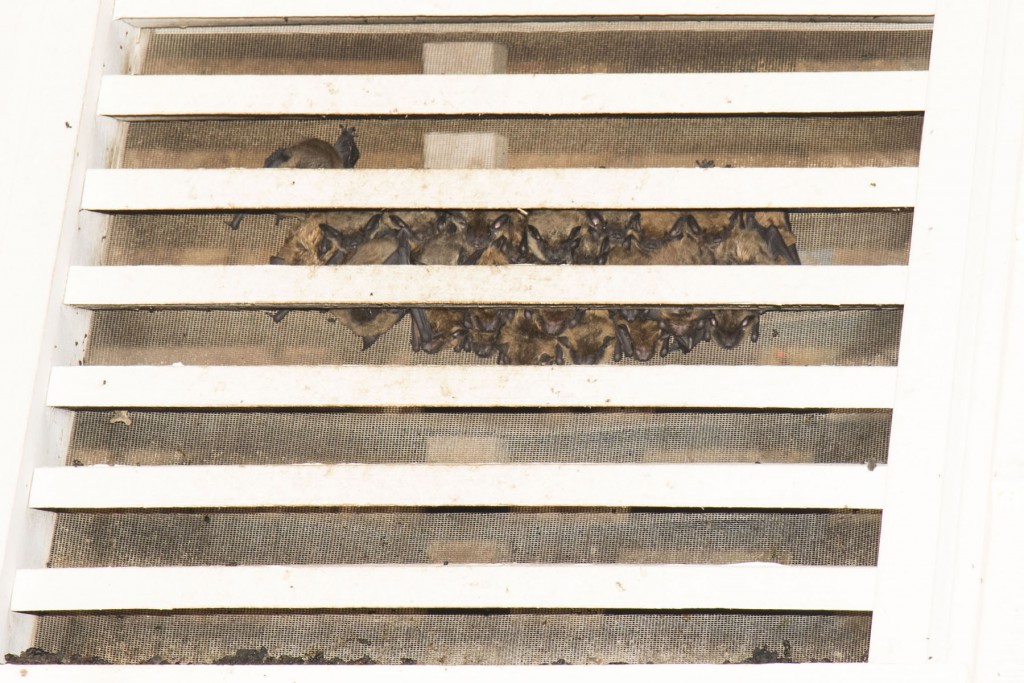Nearly 1,000 species of bats are known throughout the world, and approximately 40 species inhabit the United States. Bats are beneficial because they are efficient predators of insects. A single bat, for instance, may consume as many as 2,000 insects every night. Because flying insects are not active during the winter months, bats must either hibernate or migrate to survive the winter.

Bats do not damage or destroy property by gnawing or chewing, but their droppings may cause odor problems and potentially harbor histoplasmosis, a fungal pathogen that causes lung infections. People are more often concerned about bats because of rabies, a virus that affects the nervous system of mammals. Rabies is spread when the saliva of an infected animal enters the body through a bite or scratch.
Bats will temporarily roost on porches and patios, in garages, and behind shutters, shingles, and roof gutters. Roosting behind shutters may also be long-term in duration. Bats roost above porches or under overhangs at night to eat large prey, digest, rest, and socialize. In such cases, they may frighten people, or their droppings may accumulate. Nontoxic aerosol sprays designed to repel dogs and cats, can prevent bats from night-roosting in these areas. The spray is applied by day when bats are not present, and is reported to be effective for several months. However, aerosol repellents are not an adequate substitute for excluding bats that are using the area as a day roost, and should never be applied when bats are in a roost. Mylar balloons or strips of aluminum foil hung from the porch ceiling and allowed to move in the breeze may also discourage bats from roosting in the area.
Unlike other methods that may temporarily ward off bats, such as using ultrasonic noise-makers, repellents, shining a light, or playing a radio in the attic, bat-proofing is a permanent solution to any bat problem. A potentially useful intervention for the wall-ceiling interface under a porch is the application of a wide 45 degree molding strip to eliminate the 90 degree angle corner and force the bats to roost in a more exposed area. Gaps under corrugated and galvanized roofing may be closed with knitted wire mesh, self-expanding foam (avoid causing roofing to lift), or with fiberglass batting.
If bats are present inside an attic, holes can be blocked over a period of days early in the evening after the bats have left the structure to feed. Do this only from mid-August to mid-October (after the young bats have learned to fly and before cold weather arrives). Another window of opportunity occurs in early spring, before the birthing period in May. For several days, bat counts should be made as holes are closed, leaving the main exit open. On the night of the final count after the bats have left, the main hole should be plugged to prevent their reentry. The following evening, the plugging should be removed to allow any remaining bats to leave before the exit is permanently sealed.
A wildlife damage control company experienced in excluding bats can be hired, or you can do the exclusion work yourself. In attics and areas where large numbers of bats have been roosting for years, it is safer for you to hire a professional to do the work, including the cleanup of accumulated droppings. Never trap flightless young or adult bats inside a structure; this is needlessly cruel to the bats inside and can create a serious odor problem. There are a variety of bat exclusion devises that can be installed over existing entry holes that allow the bats to exit the structure, but prevents them from reentering. Install the exclusion devices during the day and leave them in place for five to seven days before sealing the exit hole. Another consideration is to provide an alternate roost site, such as a properly designed and installed bat house mounted close to one of their exits. Install the bat house before excluding the bats. With bat boxes, the bats get a safe roosting site outside the home, while homeowners still benefit from the bats’ control of insects.
For more information about bats, see the following websites:
https://wdfw.wa.gov/species-habitats/living/species-facts/bats
https://pcwd.info/wp-content/uploads/2016/12/1994Bats.pdf
https://extension.psu.edu/bats
https://content.ces.ncsu.edu/bats
Paul Pugliese is the Extension Coordinator and Agricultural & Natural Resources Agent for Bartow County Extension, a partnership of The University of Georgia, The U.S. Department of Agriculture, and Bartow County. (770) 387-5142. For more information and free farm, lawn, or garden publications, visit our local website at ugaextension.com/bartow .
